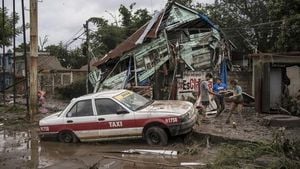In the quiet predawn hours of Tuesday, August 26, 2025, a routine morning jog in Kenai, Alaska, turned into a harrowing struggle for survival when Ariean Fabrizio Colton, a 36-year-old nurse and mother of three, was viciously attacked by a brown bear just steps from her own front door. The attack has not only shaken the small Alaskan community but also reignited conversations about the risks of living alongside the state’s abundant—and sometimes dangerously unpredictable—wildlife.
Colton, who had recently moved to southern Alaska, left her residence near the intersection of Chinook Drive around 5:45 a.m. for her usual jog. According to the Alaska Department of Public Safety, she was still near her driveway when the bear struck. Wildlife officials later pieced together that the animal, likely a brown bear bulking up on salmon and berries before winter, charged from a nearby property, ambushing Colton about 150 feet from her front porch. The bear then dragged her more than 100 yards down the road, a distance nearly the length of a football field, before vanishing into the surrounding woods.
It was a neighbor who first realized something was terribly wrong. Alaska Wildlife Trooper David Looring told KTUU, "He heard the barking, wolfing sound of a bear, he’d been around bears before and he thought a bear might have got a dog and was doing something in the neighbourhood. He didn’t really think much of it and then he heard it some more. [In] daylight, he walked out there and located a female in the woods on his property." The neighbor found Colton bloodied, in shock, and suffering from gruesome injuries to her face and scalp.
Emergency services were quickly alerted. The Kenai Police Department received a call at 6:58 a.m. reporting the bear attack. Given the severity of Colton’s injuries and the rural location, she was airlifted by helicopter nearly three hours away to a hospital in Anchorage. There, she underwent emergency surgery. Her family, facing the daunting reality of her long recovery, started a GoFundMe appeal to help cover medical costs and support her care. The campaign has since raised more than $63,700, a testament to the outpouring of support from both the local community and concerned strangers across the country. In an update posted on Saturday, August 30, her family shared, "Ariean has had her initial surgery and the doctors are positive and hopeful. It is still a long road to recovery."
The attack has left authorities and residents alike on edge. Alaska Wildlife Troopers, the Kenai Police Department, and the Alaska Department of Fish and Game launched a coordinated search for the bear, scouring the area on foot and deploying drones in hopes of locating the animal. Despite their efforts, the bear has not been found. Officials continue to patrol the area and have urged residents and visitors to remain vigilant while outdoors. The Kenai National Wildlife Refuge, which borders the community, encompasses nearly 2 million acres and is home to an estimated 2,183 different animal species, making encounters with wildlife a part of daily life—but rarely with such violent consequences.
Wildlife Trooper David Looring offered practical advice for those who venture into Alaska’s vast wilderness. "If you do get out in the woods, make sure you can hear your surroundings and what is going on," he said. "And that can be as simple as putting in one AirPod and not two." Looring’s suggestion underscores a reality for many Alaskans: the importance of staying alert, even during seemingly mundane activities like jogging near home. The incident serves as a stark reminder that in this part of the world, the line between civilization and the wild is thin—and sometimes, tragically, it vanishes altogether.
Authorities believe that the bear responsible for the attack was a brown bear, based on tracks found near the site. Brown bears, also known as grizzlies, are common in Alaska and are known to roam widely, especially in late summer and early fall as they prepare for hibernation. This period, when bears are actively seeking out high-calorie foods like salmon and berries, is when human-bear encounters are most likely. According to the Kenai National Wildlife Refuge, the region’s rich biodiversity means that residents must always be prepared for wildlife interactions, but attacks of this severity remain rare.
The investigation into the attack remains ongoing, with wildlife and law enforcement officials determined to locate the bear and prevent further incidents. Meanwhile, the community has rallied around Colton and her family, offering support and prayers for her recovery. The story has also drawn attention to the broader challenges faced by those living in remote regions where human and animal territories frequently overlap.
For many Alaskans, stories of bear encounters are a fact of life, often shared with a mix of awe and caution. Yet, as this incident shows, even the most experienced residents can find themselves in danger. The advice to stay vigilant, avoid distractions, and respect the unpredictability of wildlife is more than just common sense—it can be a matter of life and death.
As Colton begins the long process of healing, her ordeal stands as a powerful reminder of both the beauty and the peril of Alaska’s wilderness. The community’s swift response and ongoing support reflect a resilience forged by living on the frontier, where neighbors look out for one another and every day brings a new set of challenges. While the search for the bear continues and officials review safety protocols, Colton’s story will undoubtedly influence how residents approach the wild spaces that surround them.
In the aftermath of the attack, there is a renewed sense of caution in Kenai, but also a determination not to let fear overshadow the deep connection many feel to the land. For Colton and her family, the road to recovery will be long, but the hope and solidarity shown by her community offer some light in what has otherwise been a dark and difficult week.




